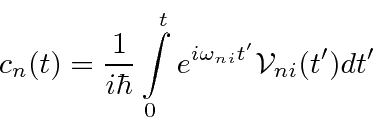Next: Radiation in Atoms Up: Course Summary Previous: Molecules Contents
We have used time independent perturbation theory to find the energy shifts of states
and to find the change in energy eigenstates in the presence of a small perturbation.
We now consider the case of a perturbation ![]() that is time dependent.
Such a perturbation can cause transitions between energy eigenstates.
We will
calculate the rate of those transitions.
that is time dependent.
Such a perturbation can cause transitions between energy eigenstates.
We will
calculate the rate of those transitions.
We derive an equation for the rate of change of the amplitude to be in the ![]() energy eigenstate.
energy eigenstate.

Assuming that at
![]() the quantum system starts out in some initial state
the quantum system starts out in some initial state ![]() ,
we derive the amplitude to be in a final state
,
we derive the amplitude to be in a final state ![]() .
.

An important case of a time dependent potential is a pure sinusoidal oscillating (harmonic) perturbation.
We can
make up any time dependence from a linear combination of sine and cosine waves.
With some calculation, we derive the transition rate in a harmonic potential of frequency
![]() .
.

 of the perturbing potential
or if there is a continuum of final states that we need to integrate over.
In either case, the delta function helps us do the integral simply.
of the perturbing potential
or if there is a continuum of final states that we need to integrate over.
In either case, the delta function helps us do the integral simply.
Jim Branson 2013-04-22